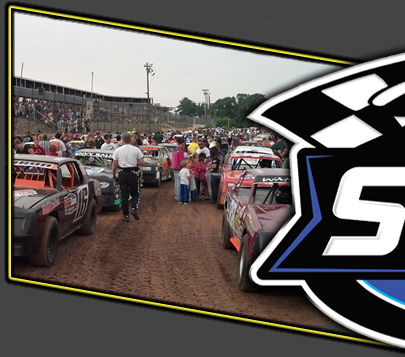 |
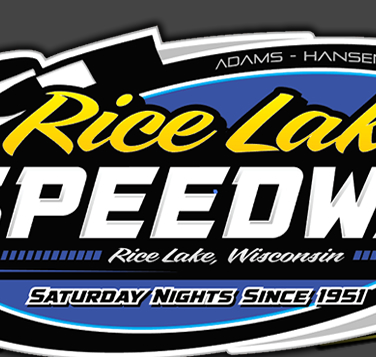 |
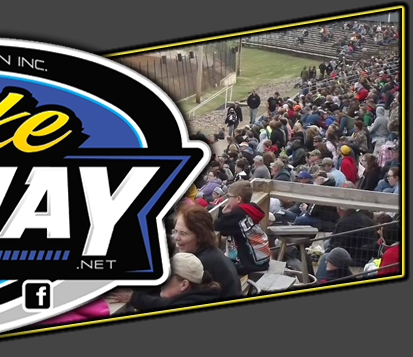 |
 |
 |
.: 2014 Hall of Fame Inductees :.
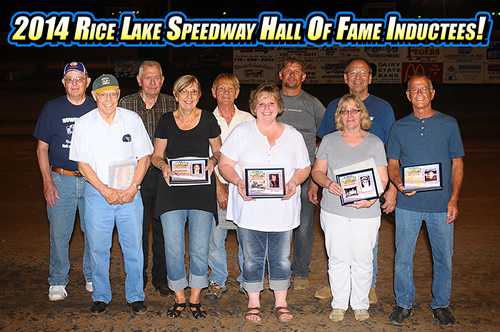
Fourth induction class. August 9, 2014.
Front, from left: Bob Heffner - promoter, Midge Kelnhofer - representing her husband Dick Kelnhofer, a promoter inductee, Patty Boortz - representing her grandfather Milo Hegna, a promoter inductee, Megan Connors - representing her father Bob Conners, a racer inductee and Dave Zimmerman - a racer inductee. Back, from left: Howie Olson - a racer inductee, Don Smith - a racer inductee, Phil Strenke - a racer inductee and speedway co-owners Mitch Hansen and Dave Adams.
| Bob Connors | |
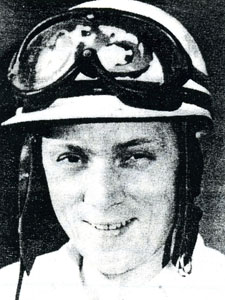 |
Perhaps no driver that ever raced at Rice Lake Speedway led as colorful and eclectic life as did Bob Connors. While he was one of the most successful drivers of his era at the speedway, the many and varied things he did off the race track made him the especially memorable and unique individual that he was. Bob first started racing at Rice Lake Speedway in 1956 when he drove a 1933 Ford Super Modified for car owner Dick Kelnhofer. Kelnhofer, by the way, is also a 2014 inductee in the Speedway Hall of Fame. But it wasn't until a few years later that Bob would start to have the success behind the wheel that would qualify him for Hall of Fame status. Between the years of 1963 and 1969 Bob won 15 feature races at Rice Lake, all while racing in the Rice Lake Stock class, which was a fore runner of today's Super Stock class and always driving the #69 car. Along with those feature wins, Bob won point championships at the track in both 1966 and 1967, the season championship in 1967, the firecracker special in 1967 and an Auqafest trophy feature in 1969. He also raced in the Late Model class in the early 1970s before retiring from racing. While he was very successful behind the wheel of a race car, what made Bob Connors such a rare individual was what he accomplished off the track. His colorful and varied life started out in high school where he was one of the first ever male cheerleaders at Rice Lake High School. He served in the Korean War and then graduated from the Layton College of Art in Milwaukee . He owned and operated for many years "The House of Truth," a well known tavern in downtown Rice Lake. He also ran for Mayor of Rice Lake on two occasions. He loved to act and performed in many local theatre productions. His passion was collecting antiques and to celebrate his 60th birthday, he took his first ever skydive. At a time when rules and safety standards at the track were a little more lax than they are today, on hot summer nights Bob was often known to drive his race car wearing Bermuda shorts to keep cool. Bob passed away in May of 2013 at the age of 79. Accepting the award for Rice Lake Speedway Hall of Famer Bob Connors is his daughter Megan Connors. |
| Bob Heffner | |
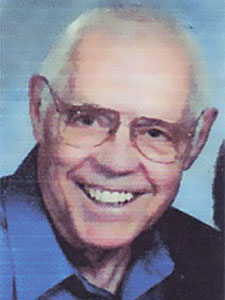 |
Bob Heffner never turned a lap in competition at Rice Lake Speedway. He never spun a wrench in the pits or scored a race. He never lined up a car on a restart or sold a fan a burger. But what he did and excelled at, helped raise the awareness of the track and put the track's name in front of the public at a time that was crucial to the track's survival. And due in part to that increased knowledge by the public, the Rice Lake Speedway began a boom era in the late 60s and 70s. As the Sports Editor of the Rice Lake Chronotype, Bob developed a friendship with many of the drivers and fans of the speedway and those friendships were just increased as Bob started covering the races at the speedway for the Chronotype as a part of his job. His weekly reports on the races at Rice Lake including photos he shot gave the speedway coverage second to none in the area and the envy of every other track in the area who struggled to get press coverage for their events. Thus was set into motion a relationship that has endured to the present as the Rice Lake Chronotype and Rice Lake Speedway have become partners as it were. The speedway does its level best to provide the information that the newspaper needs and on schedule, and the newspaper, recognizing just what a strong entertainment and economic boost the speedway provides, gives the track outstanding coverage that most tracks would kill for. Eventually Bob took on the responsibility at the speedway of sending in the weekly results to such newspapers as the Eau Claire Leader-Telegram and the St. Paul Pioneer Press. The outstanding and expanded coverage that Bob provided the speedway through the Chronotype and other area newspapers was certainly one of the factors that saw the speedway enjoy growing popularity during the 60s and 70s when some of the largest crowds in track history were recorded. Bob was Sports Editor of the Chronotype from 1960 to 1978 and was the editor of the paper from 1980 thru 1986. He was then Assistant to the Publisher until he retired in 1993. On a personal note, Bob was an accomplished baseball player during the 1950s and early 60s and enjoyed promoting fast pitch softball, particularly youth fast pitch when Rice Lake was a national power in the early 1980s. Bob is also the author of three books and a frequent contributor to the Rice Lake Chronotype. Bob and his wife Kathryn reside in Rice Lake. |
| Milo Hegna | |
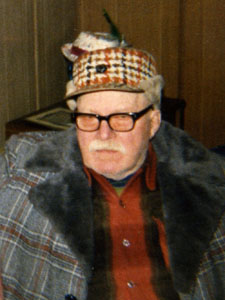 |
In the fall of 1977 at the conclusion of the race season, a complete renovation of Rice Lake Speedway unfolded. Newly elected association president Milo Hegna from Cameron set a daunting agenda that needed to be completed by the spring of 1978 so that the track could open as scheduled. Virtually everything at the track was changed, repaired or replaced. Heading the list of improvements was the track itself which was lengthened from a fifth mile oval to a high banked, oversize quarter mile track. The front straightaway was widened 30 feet and an all new, eight-foot-high retaining wall was built that lined the front straight. Additional track lights were added and all new pit lighting was installed. The old wooden planks that served as bleachers for many, many years were torn out and all new upright bleachers purchased from a company in Milwaukee and installed. Fans sat higher on the hill for a better overall view. The main entrance road was moved to the west edge of the property where it continues to be today. A new concession stand was constructed in the pits and Doc's Concession Stand on the hill was replaced by a double wide prefab school house from the Seventh Day Adventist Church. The moving expenses for the enterprise were donated by Milo. A drainage system was also installed to keep the infield free of water pockets and the judge's stand was moved from its position overhanging the front chute to a spot behind the bleachers where the officials would have a better view and could operate under much safer conditions. In addition, the north end of the pits was logged off to provide additional space for race car haulers. It was through the direction and leadership of Milo Hegna that this gigantic makeover was completed as planned and on schedule so that the 1978 summer of racing could go on as planned. Frequent visitors to the track in years past were shocked and stunned to see the transformation that had taken place and many could hardly recognize that they were at the same track! It was the first large scale renovation to the track since its founding, and it would be another 14 years before expansion and improvements took place in 1992 that saw the track go to its current third mile configuration. Certainly, it was a collective effort from the Board of Directors and the membership that made this major expansion possible, but the job wouldn?t have gotten done without Milo's vision and guidance. He would also serve as the Association's President in 1979. Simply put, Milo gave his heart and soul to Rice Lake Speedway while he was its President. For that, his name is indelibly linked to the history of Rice Lake Speedway. Milo continued to support the speedway for many years. He owned race cars for a number of years and had many of the top drivers in the region wrestle his cars around area dirt tracks. He also sponsored a number of race cars and his business also provided wrecker service to the track for decades. Milo passed away in January of 2001. Representing Rice Lake Speedway Hall of Famer Milo Hegna is his grand daughter Patty Boortz. |
| Dick Kelnhofer | |
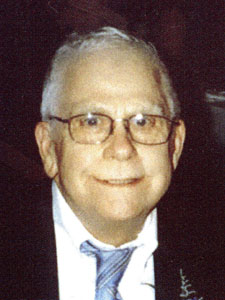 |
In just two years after he graduated from Rice Lake High School, Dick got into racing stock cars at Rice lake Speed Pit, not as a driver, but as an owner of a stock car. In 1956, he purchased a 1933 Ford Super Modified with Bob Connors as his driver and Fred Levenhagen as his mechanic with the number WEE 3. For the 1957 season he owned a 1934 Ford Super Modified with Don Brown as his driver and himself as the mechanic. Meanwhile, he attended and graduated from UW-Eau Claire with a degree in journalism and political Science. He also was on the announcing staff at WJMC from 1959 through 1965 and working for his parents in the Greenhouse business. His education and radio work would become invaluable to Rice lake Speedway. In 1958, Dick became the advertising manager of the Indianhead Stock Car Racing Association. In 1960 and thru the mid 1970s, he assumed the responsibility as Director of Public Relations at the speedway. In 1960, he began writing a weekly newsletter during the season and for the ‘62 and ’63 summer races. He also wrote and distributed the weekly racing results to all the area newspapers. In 1965, Dick and his brother Jim took over the Rice Lake Greenhouse following the passing of his father, Arnie. Around that time, Speedway Hall of Famer, Bob Heffner, took over the duties of reporting the weekly results. It was behind the microphone that Dick excelled. He frequently filled in for track announcers, Tim Moxness (aka Johnny Martin) at WJMC in the early 1960s and Butch Hazeltine in the late 60s and early 70s. He would mount speakers on top of his car and canvass the City of Rice Lake advertising that evenings races. During the races, he would climb up on top of the roof of “Doc’s” concession stand and broadcast the races live back to WJMC and for his weekly radio show. During the season, Dick hosted a 15-minute radio show on WJMC during the racing season and once did it for an entire year. In addition, he taped three-minute advertisements that aired many times each week on WJMC and other area stations as well. Dick is forever known for two well-known phrases he authored in his shows and tapes. He led off with “There they go” and closed with his trademark “We’ll see you at the races”. He also coined the phrase “WJMC on Radio Hill” which is still in use today. Dick loved what he did and all the volunteer work he did paid off for the Rice Lake Speedway during its Golden Years, the 1960s. Dick passed away in 2011, and accepting his award for him and his family is his lovely wife, Midge. |
| Howie Olson | |
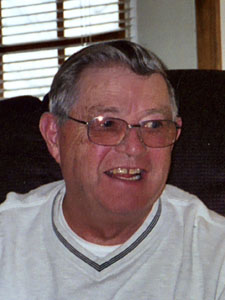 |
Howie Olson began his racing career in 1968 at a rather old age for a first time racer of 31 years of age. Howie credits Tim Lorenz and Dick Bishop as the two people most influential in him getting into racing. Howie was building race cars and working on race cars for them, so he just decided that he might as well build a race car for himself, and he did. He did most of his racing at Rice Lake Speedway and also at Racer’s Raceway in Bruce. His first racing car was a 1948 Ford with a flathead motor and his familiar #1, which was on the side of every one of his winning rides, was chosen simply because it was easy to paint on! Who could have guessed what a profound decision that was? Not only did the #1 become synonymous with Howie’s record of success, that number would be carried on by another generation of racing Olsons; Howie’s son Eric is one of the top Super Stock and Street Stock drivers in northwestern Wisconsin, evidenced by his win earlier this year in the George Rhoe Classic and double feature wins just seven days ago right here at this track. Howie’s most memorable moment at Rice Lake Speedway was when he won his first season championship in 1974. That huge honor earned him the large cash payoff of a whopping $6 and a trophy! Howie won a total of 14 feature races at Rice Lake Speedway between the years of 1974 and 1979, all in the Street Stock class. Included in those wins were 1975 and 1976 point championships, 1974 and 1975 season championships and 1975 and 1979 Auqafest trophy races. Contemporaries of Howie behind the wheel included drivers such as Geno Good, hall of famer Ben Ryba and another driver who will be inducted into the hall tonight, Phil Strenke. Howie also won three season championships and two midseason championships over those years at Racer’s Raceway. Howie was one of the drivers that sparked what was one of the strongest rivalries ever seen at the speedway and that was the rivalry between the Rice Lake area drivers and the drivers from Rusk County. The fierce battles that took place between the two factions were memorable and while occasionally things even got out of control, the epic races between the two factions made every Saturday night at Rice Lake Speedway a special place to be in those days. Just ask anyone who has been around the track for awhile and chances are, they will have a story to tell about those days. Howie credits much of his success behind the wheel of a race car to his chief mechanic and legendary engine builder, Vince Strobl who is probably the greatest story teller of them all. Howie and his wife Mary are life long residents of the city of Ladysmith. |
| Don Smith | |
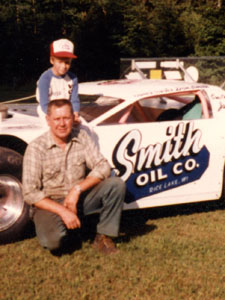 |
Don began racing at Rice Lake Speed Pit in 1955 which was just the fourth season of racing at the north side oval. His first car was a 1938 Ford coupe, 85 horsepower flathead powered car that he purchased from the Ben Resnick Rice Lake Auto Salvage for $15 and then he drove it home to his residence in Dallas. His well known and distinctly recognizable #VC3 was taken from an advertisement on a box at the Ridgeland Creamery. The number was actually #V3C but when the painters inverted the numbers when they put it on the race car, Don just left it as #VC3 and thus a legendary identification was born that would follow him in his racing career for the next six decades. During his long and storied career, Don has raced at 19 different area tracks. He also raced in several different divisions of cars here at Rice Lake. His racing records show five wins in the Sportsman class which evolved into the WISSOTA Modifieds with three wins in 1980 and two more in 1982. He is also credited with two wins in the original Modified class in 1958 and numerous other wins further back in the track’s history that have been difficult to document due to a lack of records. Don is also credited with running some of the most unique race cars ever seen at the speedway including his Corvette Late Model and when he returned to racing in 1980 when the Sportsman Modified class was started, his Pinto station wagon that was affectionately referred to as the Pink Panther due to its graphics and color. But for Don, it was never about the sheer number of feature wins or losses, but about the enjoyment and camaraderie of the sport. And Don is not being inducted into the Hall of Fame based on his number of wins and titles but for what he has done for the sport of auto racing and for Rice Lake Speedway in particular. In the Fall of 2001, Don and his wife Maxine, their daughter Debbie and son-in-law Dale Bisonette and their children purchased Rice Lake Speedway from the Indianhead Stock Car Racing Association when the club was in dire straits and on the verge of collapse which would have left the track in a very precarious position. Despite having no experience in operating a race track, they had business experience and immediately began construction of a state of the art restaurant overlooking turn four which is still enjoyed by race fans to this day. They also completely blacktopped the seating area on the hill, landscaped the track grounds particularly on the southeast section of the property, put up new fencing around the track and cleared land on the north end of the pit area allowing for additional space in the pits now welcomed by today’s increasingly large tow rigs. New buildings and more bleachers were added when the speedway hosted the WISSOTA 100. After nine years and eight summers of racing, Don and his family sold the track to Dave Adams and Mitch Hansen in the spring of 2010. Don was self employed with the Texaco Oil Company in Rice Lake for 30 years and he and his wife have owned Maxine’s Family Restaurant in Rice Lake for 22 years. They have long supported many Dallas area racers along with their family members with the latest to fly the colors of Maxine’s on the side of Aric Lindberg’s Modified. Don and his wife Maxine reside in Dallas where Don still works at his machine shop, restoring cars, trucks and motorcycles and he reports he has built a new Pink Panther modified which perhaps he can share with his many fans at the track at some point. |
| Phil Strenke | |
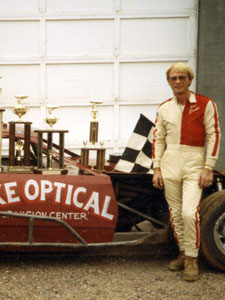 |
Phil had a racing career that spanned four decades at the Rice Lake Speedway. He first started racing in the mid to late 60s with a 1953 Plymouth with a six-cylinder flathead motor in the Rice Lake Stock Car class. He also raced in the Street Stock class and wrapped up his career running in the Modified class. His familiar number #24, with which he used to gain the majority of his feature wins, was numbered as such because his birthday is on the 24th of December, on Christmas eve. Phil recorded a total of 53 feature wins at Rice Lake Speedway, which is sixth on the all time win list. His first feature win came during the 1972 race season and between 1972 and 1976 he won four times in the Rice Lake Stock class driving the #24 car. His greatest success came between 1975 and 1984 when he won 35 feature races driving in the Street Stock class using cars numbered #24, #21 and #44. He wrapped up his racing career in the Modified class, again driving the #24 car to 14 feature wins with his last win coming during the 1989 race season. Along the way he set some track records that still stand. In 1977 he set a track record with 14 feature wins in one season in the Street Stock class that included the point championship and the season championship, the midseason championship, the Firecracker special and the Aquafest trophy feature event. In 1988 he had another huge year racing the Modified when he won the point title and season championship race, the Aquafest feature race and the Modified invitational. He won three point championships and four season championships in his racing career at Rice Lake. Yet for all his many feature wins and titles earned, Phil recalls that his favorite memories in racing involve the challenges provided by his fellow racers and the camaraderie provided by the members of his pit crew. Phil gives all the credit for his success on the track to his pit crew and particularly to his crew chief and friend Al Rettenmund who set up, designed and provided engine expertise for all his race cars. Others on the crew include Gene Lindstrom who was the one most influential in getting Phil involved in racing along with the rest of the crew that included Clayton “Groovy” Hargrave, Craig “Marty” Larson, Mike Kisling, Tommy Tucker, Mark Zimmer, Gary Aldridge, Grant Burdick, Steve Winkler and Phil’s son Shane who are all in attendance tonight and will no doubt help him celebrate this high honor. Phil and his wife, Cindy reside in Rice Lake. |
| Dave Zimmerman | |
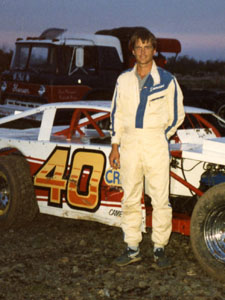 |
Seldom, if ever, has there been a more athletically gifted driver that raced at Rice Lake Speedway than Dave Zimmerman. Known simply as “Z”, Dave was a three sport star at Cameron High School when he graduated in 1974. His feats on the gridiron, hardwood court and diamond were legendary for the Comets; he displayed both tremendous athletic ability and a fierce, competitive drive to excel. That drive quickly transferred to the dirt track and was evident the very first time he got behind the wheel of a race car in 1983. He won the very first heat race he entered that year and then came back to win the feature race that same night, a night he still claims to be his most memorable racing experience. Dave was also fortunate to have driven for some of the top teams and most highly regarded car owners in the area. He was influenced to start driving by Rick Kurshinsky, whose chassis are still considered to be among the best available on the market for Street Stock drivers. Dave drove for Kurshinsky in the Street Stock class and then transitioned to the Super Stocks where he drove for Brad Kisling. Dave drove the #21 in the Street Stocks - his number on the athletic field at Cameron - then drove the #6 car in the Supers, which is still used by Brad’s son Shane who currently races in the Super Stock class. Dave won 16 feature races in the first two years he raced when some of the top drivers he raced against included Rod Hensel, Phil Strenke, Rory Taber, Rich Bishop, Todd Madsen and Mickey Nosser. In 1985 Dave moved up to the Modified class where he teamed up with Dave Adams in identical looking #40 open-wheel cars that they raced at Rice Lake along with Red Cedar in Menomonie and at Superior. Racing against the top drivers of that time that included Dave Morgan, Dave Mayala, Phil Strenke, Rick Ellis and Adams, Dave won 15 times in the Modified at Rice Lake between 1985 and 1993 and then came back for an encore performance in 1995 when he won one last feature race in the Super Stocks. All told, he won 32 feature races at the track in just over a decade. Among his accomplishments were point championships at Rice Lake in 1985 and 1987 in the Modified, season championships in 1983 and 1984 in the Street Stock, season championships in the Modified in 1986 and 1991, a midseason championship in 1983 in the Streets, Firecracker special wins in 1983 in the Streets and 1987 in the Modifieds, Auqafest trophy race wins in 1983 and 1984 in the Streets and a Best Appearing Car award in 1984 in the Street Stocks. His contemporaries would say that the thing they most remember about Dave on the track was his absolutely fierce desire to win, a zeal for victory that was shaped on the fields of combat at Cameron High School. Dave is currently Plant Manager at Smithco, a company that manufactures turf maintenance equipment both for the domestic and international business market. Dave and his wife Lorrie reside in Cameron. |
Class of 2020 | Class of 2019 | Class of 2018 | Class of 2017 | Class of 2016 |
Class of 2015 | Class of 2014 | Class of 2013 | Class of 2012 | Class of 2011
 |